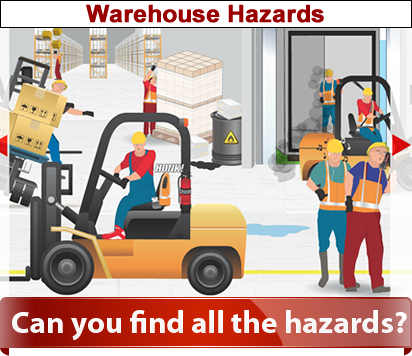How To Find Safety Hazards In A Warehouse

Warehouse safety hazards lurk in every corner of a business building. Diligent employees who have learned what it takes to create hazards will work toward preventing them. It not only applies to machinery and equipment, but it also involves daily activities. Disposal of trash, broken containers, and chemicals such as paints and solvents must be handled appropriately to prevent fire and safety hazards. Keeping the floor and walkways clear of any debris is of utmost importance.
Instructions
1.Watch for pieces of plastic bags and wrappings in the aisles and walk ways. Most plastic is slippery and can cause a fall.
2.Check trash bins and trash cans for overflow, which is not only unsightly but can also cause falls.
Check stairways to make sure there are handrails that are in good condition.
3.Observe shelves which contain products. Broken glassware and metal items can cause serious injuries. Broken containers of many products that contain chemicals may be dangerous. Look for seriously overstocked shelves or shelves that have products stacked too high to be safe.
4.Check electrical outlets for overloaded connections. Too many appliances plugged into one socket can be a fire hazard. Watch for the use of extension cords that are not sufficient to carry the current.
Check for available fire extinguishers in appropriate areas.
5.Observe the floors for spills of liquids and other products that will cause falls.
6.Check closets and corners where flammable liquids may be stored too close to dry goods.
7.Ensure that first aid kits and supplies are in each work area or in a general designated area. Emergency numbers should also be posted visibly near a phone.
Instructions
1.Watch for pieces of plastic bags and wrappings in the aisles and walk ways. Most plastic is slippery and can cause a fall.
2.Check trash bins and trash cans for overflow, which is not only unsightly but can also cause falls.
Check stairways to make sure there are handrails that are in good condition.
3.Observe shelves which contain products. Broken glassware and metal items can cause serious injuries. Broken containers of many products that contain chemicals may be dangerous. Look for seriously overstocked shelves or shelves that have products stacked too high to be safe.
4.Check electrical outlets for overloaded connections. Too many appliances plugged into one socket can be a fire hazard. Watch for the use of extension cords that are not sufficient to carry the current.
Check for available fire extinguishers in appropriate areas.
5.Observe the floors for spills of liquids and other products that will cause falls.
6.Check closets and corners where flammable liquids may be stored too close to dry goods.
7.Ensure that first aid kits and supplies are in each work area or in a general designated area. Emergency numbers should also be posted visibly near a phone.
- lz867790336b2ac1c4be265c36808343a2.jpg